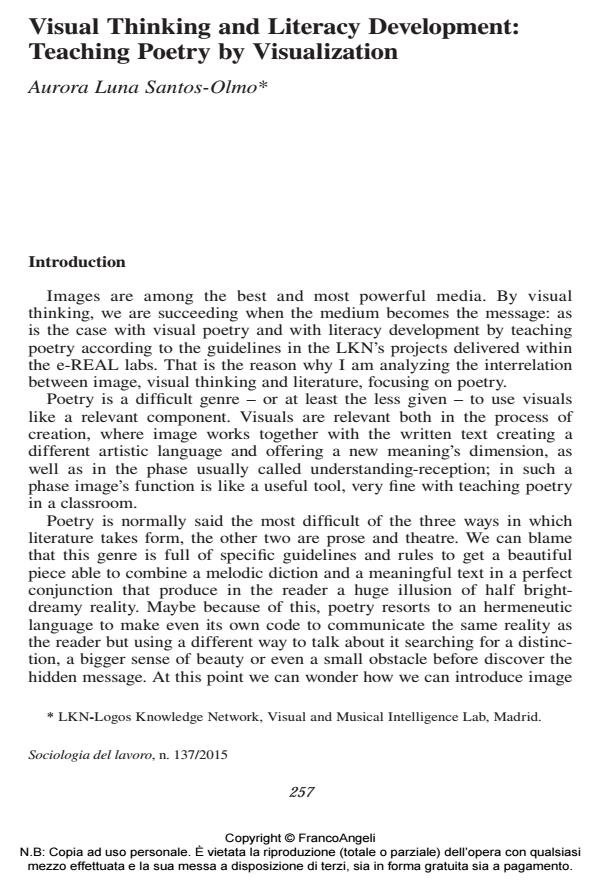Visual Thinking and Literacy Development: Teaching Poetry by Visualization
Titolo Rivista SOCIOLOGIA DEL LAVORO
Autori/Curatori Aurora Luna Santos-Olmo
Anno di pubblicazione 2015 Fascicolo 2015/137
Lingua Inglese Numero pagine 13 P. 257-269 Dimensione file 175 KB
DOI 10.3280/SL2015-137016
Il DOI è il codice a barre della proprietà intellettuale: per saperne di più
clicca qui
Qui sotto puoi vedere in anteprima la prima pagina di questo articolo.
Se questo articolo ti interessa, lo puoi acquistare (e scaricare in formato pdf) seguendo le facili indicazioni per acquistare il download credit. Acquista Download Credits per scaricare questo Articolo in formato PDF

FrancoAngeli è membro della Publishers International Linking Association, Inc (PILA)associazione indipendente e non profit per facilitare (attraverso i servizi tecnologici implementati da CrossRef.org) l’accesso degli studiosi ai contenuti digitali nelle pubblicazioni professionali e scientifiche
The United Nations Educational, Scientific and Cultural Organization (UNESCO) defines literacy as the ability to identify, understand, interpret, create, communicate and compute, using printed and written materials associated with varying contexts. Literacy involves a continuum of learning in enabling individuals to achieve their goals, to develop their knowledge and potential, and to participate fully in their community and wider society. Images are among the best and most powerful media. By visual thinking, we are succeeding when the medium becomes the message: that is the case with visual poetry and with literacy development by teaching poetry accordingly with the guidelines from the LKN’s projects delivered within the e-REAL labs. That is the reason why in the paper are analyzed the interrelation between image and literature, focusing on poetry. Poetry is the more difficult genre - or at least the less given - to use visuals like a relevant component. Visuals are relevant both in the process of creation, where image works together with the written text creating a different artistic language and opening a new hermeneutic dimension, as well as in the understanding-reception, where image’s function is like a useful tool to teach poetry in a classroom.
L’UNESCO definisce ‘literacy’ come l’abilità di identificare, comprendere, interpretare, creare, comunicare e calcolare utilizzando materiali scritti e stampati correlati a differenti contesti. La ‘literacy’, ovvero l’accrescimento delle competenze di case, riguarda un processo continuo di apprendimento che abilita le persone a raggiungere i loro obiettivi, ad accrescere sia le loro conoscenze che le loro potenzialità, così come a partecipare pienamente alla vita sia della loro comunità di appartenenze che alla società intesa in termini più. Le immagini sono tra i migliori e più potenti mezzi di comunicazione. Tramite il pensiero visivo, otteniamo risultati positivi quando il mezzo diventa il messaggio: è il caso della poesia visiva e dell’accrescimento delle competenze di base promossi tramite l’insegnamento della poesia, in conformità alle linee-guida dei progetti di LKN realizzati all’interno dei laboratori e-REAL. Per questa ragione, nel presente saggio analizzo l’interrelazione tra immagini e letteratura, concentrandomi sulla poesia. La poesia è il genere più difficile, o perlomeno quello meno incline a utilizzare gli elementi visivi come componenti fondamentali. Gli elementi visivi sono rilevanti sia nel processo di creazione, in cui l’immagine s’intreccia al testo scritto, creando un linguaggio artistico differente e aprendo una nuova dimensione ermeneutica, sia nel processo di comprensione-ricezione, laddove la funzione dell’immagine funge da strumento utile per l’insegnamento della poesia in classe.
Parole chiave:Pensiero visivo, sviluppo dell’alfabetizzazione, poesia, storie di successo
Aurora Luna Santos-Olmo, Visual Thinking and Literacy Development: Teaching Poetry by Visualization in "SOCIOLOGIA DEL LAVORO " 137/2015, pp 257-269, DOI: 10.3280/SL2015-137016